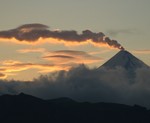14 June 2011
WASHINGTON—On average, human activities put out in just three to five days the equivalent amount of carbon dioxide that volcanoes produce globally each year. So concludes a scientist who reviewed five published studies of present-day global volcanic carbon dioxide emissions and compared those emissions to anthropogenic (human-induced) carbon dioxide output.

Shishaldin Volcano at sunset. Shishaldin is on Unimak Island, part of Izembek National Wildlife Refuge, Alaska.
CREDIT: Cyrus Read, USGS
“The most frequent question that I have gotten (and still get), in my 30 some years as a volcanic gas geochemist from the general public and from geoscientists working in fields outside of volcanology, is ‘Do volcanoes emit more carbon dioxide than human activities?’” says Terrance Gerlach of the U.S. Geological Survey. “Research findings indicate unequivocally that the answer to this question is ‘No’—anthropogenic carbon dioxide emissions dwarf global volcanic carbon dioxide emissions.”
This is one of the messages detailed in a new article by Gerlach published today in Eos, the weekly newspaper of the Earth and space sciences. The article is publicly available for download. Eos is a publication of the American Geophysical Union.
The studies reviewed by Gerlach give a range of results for volcanic carbon dioxide emissions, from a minimum of about one tenth of a billion to a maximum of about half a billion metric tons of carbon dioxide per year. Gerlach used the figure of about one-quarter of a billion metric tons of volcanic carbon dioxide per year to make his comparisons. The published projected anthropogenic carbon dioxide emission rate for 2010 is about 35 billion metric tons per year. (In U.S. tons —i.e., “short” tons— the above figures are approximately 10 percent greater.)
Gerlach’s calculations suggest present-day annual anthropogenic carbon dioxide emissions may exceed the carbon dioxide output of one or more supereruptions. As he notes in the Eos article, “Supereruptions are extremely rare, with recurrence intervals of 100,000-200,000 years; none have occurred historically, the most recent examples being the Toba eruption 74,000 years ago in Indonesia and the Yellowstone caldera eruption in the United States 2 million years ago.”
Although geoscientists continue in their efforts to improve estimates and reduce uncertainties about how much carbon dioxide is released from mid-ocean ridges, from volcanic arcs, and from hot spot volcanoes, agreement exists among volcanic gas scientists regarding the significantly smaller emissions of volcanic carbon dioxide compared to anthropogenic carbon dioxide.
AGU Contact
Peter Weiss, Phone: +1 202 777 7507, E-mail: [email protected]
USGS Contacts
David Hollingsworth, Phone: +1 360 993 8973, E-mail: [email protected]
Justin Pressfield, Phone: +1 916 335 1211, E-mail: [email protected]
If you wish to receive the full 14 June 2011 issue of Eos, it is also now available online for members of the news media. Those who have previously registered with the American Geophysical Union (AGU) for access to scientific papers cited in AGU press releases may download the current Eos.
Or, you may order a copy of the full Eos by emailing your request to Peter Weiss at [email protected]. Please provide your name, the name of your publication, and your phone number.
Neither the Gerlach article nor this press release are under embargo.
“Volcanic Versus Anthropogenic Carbon Dioxide”
Terry GerlachCascades Volcano Observatory (Emeritus), U.S. Geological Survey, Vancouver, Wash.;
Terrance Gerlach, email address: [email protected]
To register with AGU for press access to Eos and other AGU publications, please contact Peter Weiss ([email protected], +1 (202) 777-7507) or Maria-José Viñas ([email protected], +1 (202) 777-7530).